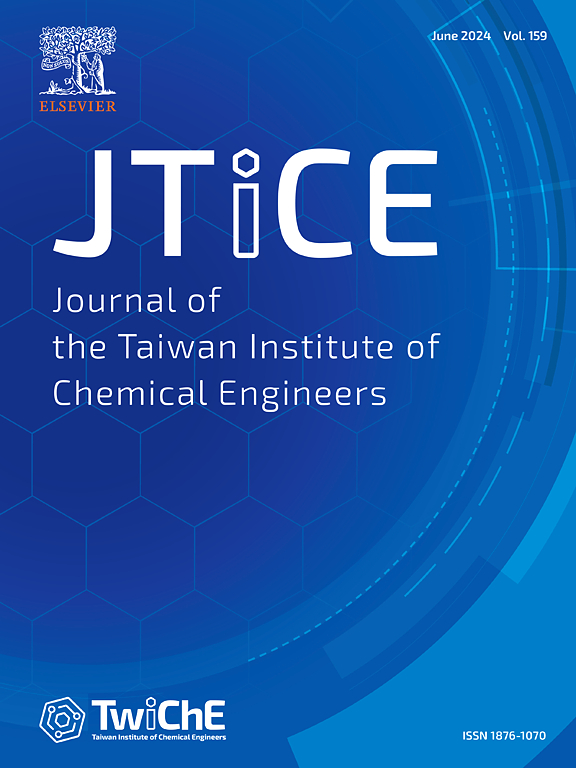Response surface methodology optimized co-pyrolysis of mixed date seeds and chicken bones for bio-oil production
IF 5.5
3区 工程技术
Q1 ENGINEERING, CHEMICAL
Journal of the Taiwan Institute of Chemical Engineers
Pub Date : 2025-03-12
DOI:10.1016/j.jtice.2025.106070
引用次数: 0
Abstract
Background
Co-pyrolysis of date seeds (DS) and chicken bone (CB) mixture in a fixed bed reactor to produce pyrolytic oil (PO). The process was adjusted using Central Composite Design (CCD) followed by Response surface methodology (RSM) to produce an optimal PO yield.
Methods
To evaluate the pattern and relation between the experimental responses and the process variables, the variables, including temperature (400 °C - 600 °C), feedstock particle size (0.15–0.35 mm), heating rate (10–50 °C/min), and time (40–80 min), were investigated.
Significant Findings
The extreme output of the PO was 65.11 % and was produced at 500 °C using a 0.25 mm particle size and a heating rate of 30 °C/min for 60 min. Quantifying the bio-oil (BO) by GC–MS analysis showed the BO consisted mostly of oxygenated hydrocarbons (73.16 %), including acids (64.16 %), aldehydes and ketone (4.45 %), esters (4.20 %), and alcohols (0.35 %). Other components included hydrocarbons (33.84 % (paraffin, 16.89 %; olefines, 16.3 %; and alkynes, 0.65 %)) and nitrogen compounds (5.79 %). In conclusion, the mixed DSCB can be used as a resource for pyrolysis and produce a complex mixture of acids, esters, and alkanes.

响应面法优化了混合枣籽和鸡骨共热解生产生物油的工艺
研究背景枣籽(DS)和鸡骨(CB)混合物在固定床反应器中共热解生产热解油(PO)。采用中心复合设计(CCD)和响应面法(RSM)对工艺进行调整,以获得最佳的PO产率。方法考察了温度(400℃~ 600℃)、原料粒度(0.15 ~ 0.35 mm)、升温速率(10 ~ 50℃/min)、升温时间(40 ~ 80 min)等工艺变量对实验响应的影响规律和关系。在温度500℃,粒径0.25 mm,加热速率30℃/min,加热60 min的条件下,生物油的最高收率为65.11%。通过气相色谱-质谱分析,生物油主要由含氧烃(73.16%)组成,包括酸(64.16%),醛和酮(4.45%),酯(4.20%)和醇(0.35%)。其他成分包括烃类(33.84%)(石蜡,16.89%;烯烃,16.3%;炔(0.65%)和氮化合物(5.79%)。综上所述,混合DSCB可以作为热解资源,生成酸、酯和烷烃的复杂混合物。
本文章由计算机程序翻译,如有差异,请以英文原文为准。
求助全文
约1分钟内获得全文
求助全文
来源期刊
CiteScore
9.10
自引率
14.00%
发文量
362
审稿时长
35 days
期刊介绍:
Journal of the Taiwan Institute of Chemical Engineers (formerly known as Journal of the Chinese Institute of Chemical Engineers) publishes original works, from fundamental principles to practical applications, in the broad field of chemical engineering with special focus on three aspects: Chemical and Biomolecular Science and Technology, Energy and Environmental Science and Technology, and Materials Science and Technology. Authors should choose for their manuscript an appropriate aspect section and a few related classifications when submitting to the journal online.

 求助内容:
求助内容: 应助结果提醒方式:
应助结果提醒方式:


